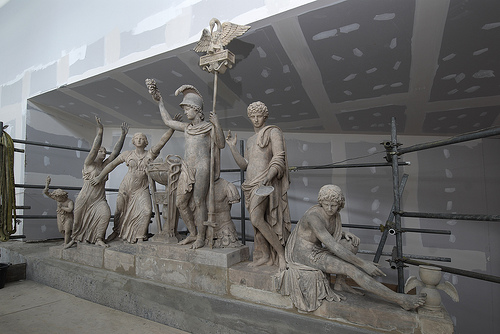The Museum of London and the Mystery of Eleanor Coade’s Stone
As you wander from the Museum’s Galleries of Modern London to the cafe for a nice cup of something and a sit down, just take a moment to look up and right. Up there, in the niche on the wall is a group of figures, smaller than adults but bigger than children. They look much like any other Classical sculpture, apart from their size but there is something about the material that is not only intriguing, but remarkable. This tableau is made from Coade stone, an early form of ‘fake’ stone. Finer than cement and far more durable, the exact composition of Coade is still unknown, but it is closer to a ceramic than a stone and this is no surprise, for Eleanor Coade herself was from a famous family of ceramicists in Lyme Regis in Dorset. Although patents for similar ‘fake stone’ existed from the early 1720s, it was Coade, with her factory in Lambeth (where the Royal Festival Hall now stands) who, from 1769 made such a success of artificial stone.
The secrets of her success lay in the very fine nature of her Coade stone, which allowed it to be cast into very high relief, the good taste and fine workmanship displayed in its execution and its durability. Architectural historian Sir John Summerson noted that he had entered burned out churches where all that remained were the Coade ornaments; other Coade pieces around London include the still-crisp doorway of the Twinings tea shop in the Strand and the lion on the south side of Westminster Bridge.
Coade passed her factory to her daughter, also Eleanor, but the success of the business was already over by the Victorian period when the formula was finally lost. Coade, both the woman and the stone, were a marvel of the Georgian period and she is sadly neglected as one of the greatest artisan industrialists of the age.
(The photograph featured here is from the redevelopment of the Museum, and of course now it is all painted and beautiful - but this image reminds me of how the piece would have sat in the yard at Lambeth, surrounded by the detritus of its manufacture, waiting to go to its new home.)
The secrets of her success lay in the very fine nature of her Coade stone, which allowed it to be cast into very high relief, the good taste and fine workmanship displayed in its execution and its durability. Architectural historian Sir John Summerson noted that he had entered burned out churches where all that remained were the Coade ornaments; other Coade pieces around London include the still-crisp doorway of the Twinings tea shop in the Strand and the lion on the south side of Westminster Bridge.
Coade passed her factory to her daughter, also Eleanor, but the success of the business was already over by the Victorian period when the formula was finally lost. Coade, both the woman and the stone, were a marvel of the Georgian period and she is sadly neglected as one of the greatest artisan industrialists of the age.
(The photograph featured here is from the redevelopment of the Museum, and of course now it is all painted and beautiful - but this image reminds me of how the piece would have sat in the yard at Lambeth, surrounded by the detritus of its manufacture, waiting to go to its new home.)

































